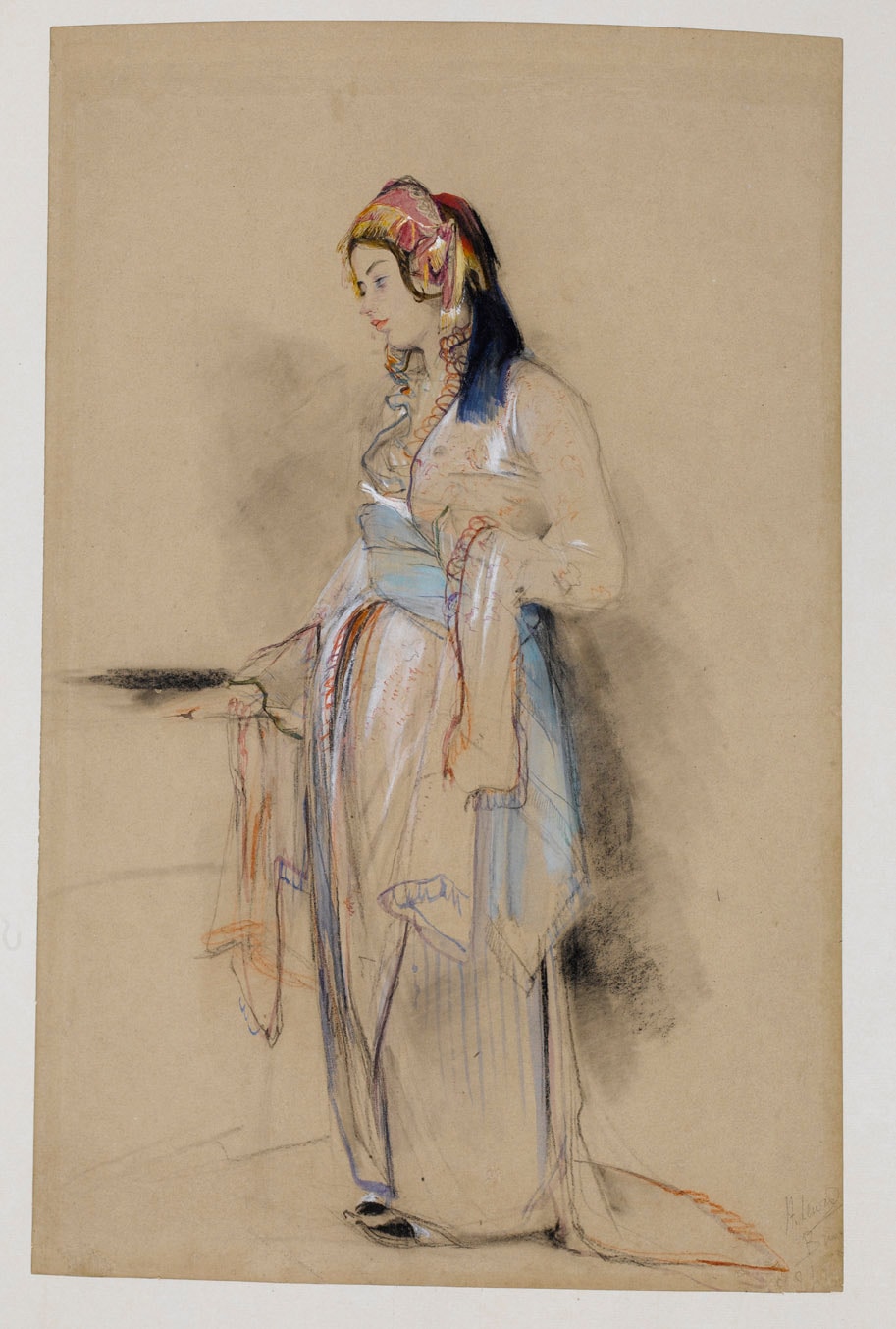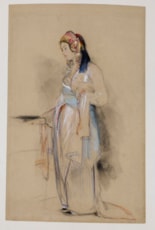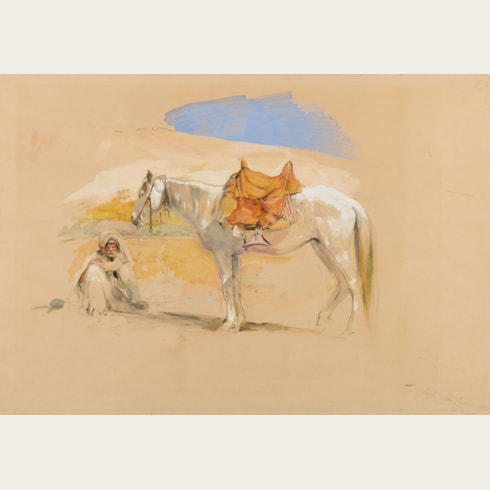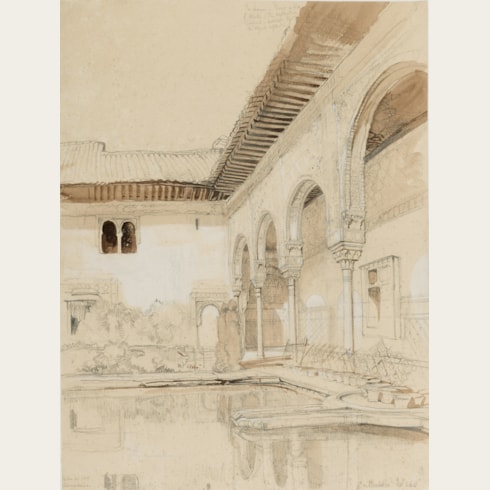John Frederick LEWIS
(London 1805 - Walton-on-Thames 1876)
A Young Woman from Bursa
Sold
Black chalk and watercolour, heightened with touches of gouache, on light brown paper.
Signed and inscribed Jf. Lewis / Brus[sa] in pencil at the lower right.
418 x 271 mm. (16 3/8 x 10 5/8 in.)
Signed and inscribed Jf. Lewis / Brus[sa] in pencil at the lower right.
418 x 271 mm. (16 3/8 x 10 5/8 in.)
Between 1840 and 1841 John Frederick Lewis spent almost a year living in Constantinople. The first recorded mention of his arrival in the city occurs in two letters written by his fellow artist David Wilkie on the 14th and 15th of October, 1840; ‘We have encountered John Lewis from Greece and Smyrna…He has been making most clever drawings as usual.’ Some time in 1841 Lewis visited the town of Bursa (then called Brussa), about one hundred miles south of Constantinople in northwestern Turkey. A centre of the silk trade, Bursa in the 19th century was populated by peoples of different ethnic origins hailing from the Ottoman territories in Europe. Lewis made a number of splendid drawings of the local inhabitants, as well as some of the main sites of the city, such as the late 14th century mosque of Ulu Cami and the Yesil Türbe, the mausoleum of Sultan Mehmet I, built in the 1420s.
The present sheet, as shown by the signature and inscription at the lower right, was drawn during the artist’s stay in Bursa in 1841. The fact that the woman depicted in this drawing is not veiled would indicate that she was not Muslim but rather a Christian of an Eastern denomination, probably from an Armenian merchant family in Bursa. It seems likely that, during his stay in Bursa, Lewis gained access to the home of a wealthy local Armenian family, to judge from the handful of drawings he produced of female members of the same family in the interior of what appears to be their home. The same young woman, for example, is seen at the left of a larger, finished watercolour by Lewis depicting four women in an interior, also signed and dated ‘Brussa 1841’, which recently appeared at auction in London and is today in the Omer M. Koç collection in Istanbul. The same model also appears in another of Lewis’s Bursa drawings of 1841; a study of two women in the collection of the Whitworth Art Gallery of the University of Manchester, of which a second, unsigned version was recently on the art market in London. A larger, unsigned autograph replica of the present sheet is in the collection of the British Museum.
As Briony Llewellyn has noted, chief among Lewis’s reasons for travelling to the Near East in 1840 was ‘a desire for novelty, a need to infuse his art with exotic and colourful subjects that represented a culture other than European. Surviving sketches suggest that his sole aim was to accumulate ethnographic information, but with an unprecedented accuracy and comprehensiveness...Lewis’s images are often of anonymous native men and women, in which the focus is as much on the elaborate details of their costume as on their individuality.’
The present sheet, as shown by the signature and inscription at the lower right, was drawn during the artist’s stay in Bursa in 1841. The fact that the woman depicted in this drawing is not veiled would indicate that she was not Muslim but rather a Christian of an Eastern denomination, probably from an Armenian merchant family in Bursa. It seems likely that, during his stay in Bursa, Lewis gained access to the home of a wealthy local Armenian family, to judge from the handful of drawings he produced of female members of the same family in the interior of what appears to be their home. The same young woman, for example, is seen at the left of a larger, finished watercolour by Lewis depicting four women in an interior, also signed and dated ‘Brussa 1841’, which recently appeared at auction in London and is today in the Omer M. Koç collection in Istanbul. The same model also appears in another of Lewis’s Bursa drawings of 1841; a study of two women in the collection of the Whitworth Art Gallery of the University of Manchester, of which a second, unsigned version was recently on the art market in London. A larger, unsigned autograph replica of the present sheet is in the collection of the British Museum.
As Briony Llewellyn has noted, chief among Lewis’s reasons for travelling to the Near East in 1840 was ‘a desire for novelty, a need to infuse his art with exotic and colourful subjects that represented a culture other than European. Surviving sketches suggest that his sole aim was to accumulate ethnographic information, but with an unprecedented accuracy and comprehensiveness...Lewis’s images are often of anonymous native men and women, in which the focus is as much on the elaborate details of their costume as on their individuality.’
After some early success as a painter, mostly of animal subjects (an interest he shared with his childhood friend and neighbour Edwin Landseer), John Frederick Lewis seems to have largely given up painting around 1830, in favour of drawings and finished watercolours. These works were exhibited at the Society of Painters in Water-Colours (to which he had been elected as an associate in 1827, at the age of just twenty-one), the Royal Academy, the British Institution and elsewhere. He made his first trip abroad in 1827, visiting Belgium, Germany, Switzerland and Italy. Between 1832 and 1834 Lewis lived and worked in Spain, producing numerous drawings, watercolours and lithographs of local sights, figures, costumes, buildings and landscapes. Spanish subjects dominated his exhibited output of finished watercolours for most of the succeeding years, as well as two volumes of lithographs published in 1835 and 1836, earning him the nickname ‘Spanish Lewis’. In 1837 Lewis left London to travel to Italy, where he spent two years, and from there went on to Greece, Albania and Turkey before eventually settling in Egypt at the end of 1841.
Lewis resided in Cairo for ten years, living as an Oriental gentleman in an elegant Ottoman house in the Azbakiyyah quarter of the city, dressing in the Turkish manner and enjoying what one visitor, the writer William Makepeace Thackeray, described as a ‘dreamy, hazy, lazy, tobaccofied life.’ He produced a large number of watercolours and drawings during his decade in Egypt before his return to England in 1851. For the remainder of his career he painted Orientalist subjects inspired by his years in the East, and based largely on the drawings made in Cairo. These depictions of mosques, bazaars, Eastern interiors, desert encampments and imaginary harem scenes proved immensely popular with collectors. In 1855 Lewis was elected President of the Society of Painters in Water-Colours, although the previous year he had also begun to exhibit paintings at the Royal Academy. His growing interest in oil painting, at the expense of watercolours, led him in February 1858 to resign from the Old Water-Colour Society, and for the remainder of his career Lewis’s exhibited works were mainly paintings. Elected an Associate of the Royal Academy in 1859 and an Academician in 1864, Lewis showed regularly at the Academy until his death in 1876.
Lewis’s paintings and watercolours of exotic Eastern subjects, executed in a meticulous and detailed manner, remained popular with collectors and connoisseurs throughout the later stages of his career. As his fellow artist and traveller Edward Lear noted, in a letter to Lewis’s wife written the year before the painter’s death, ‘There have never been, and there never will be any works depicting Oriental life – more truly beautiful and excellent – perhaps I might say - so beautiful and excellent. For, besides the exquisite and conscientious workmanship, the subjects painted by J. F. Lewis were perfect as representations of real scenes and people.’
Provenance
Carl Winter, London and Cambridge
By descent to his wife, Theodora Gertrude Winter, London
Thence by descent until 2010.
Literature
Michael Lewis, John Frederick Lewis, R.A. 1805-1876, Leigh-on-Sea, 1978, p.100, no.650 (‘A Turkish Lady, Brussa’); London, Christie’s, Orientalist Art, 15 June 2010, p.14, under lot 10; Briony Llewellyn, ‘Drawing from Life’, Cornucopia: Turkey for Connoisseurs, No.45, 2011, illustrated p.66; London, Christie’s, 19th Century European Art, 12 June 2012, p.90, under lot 70.







